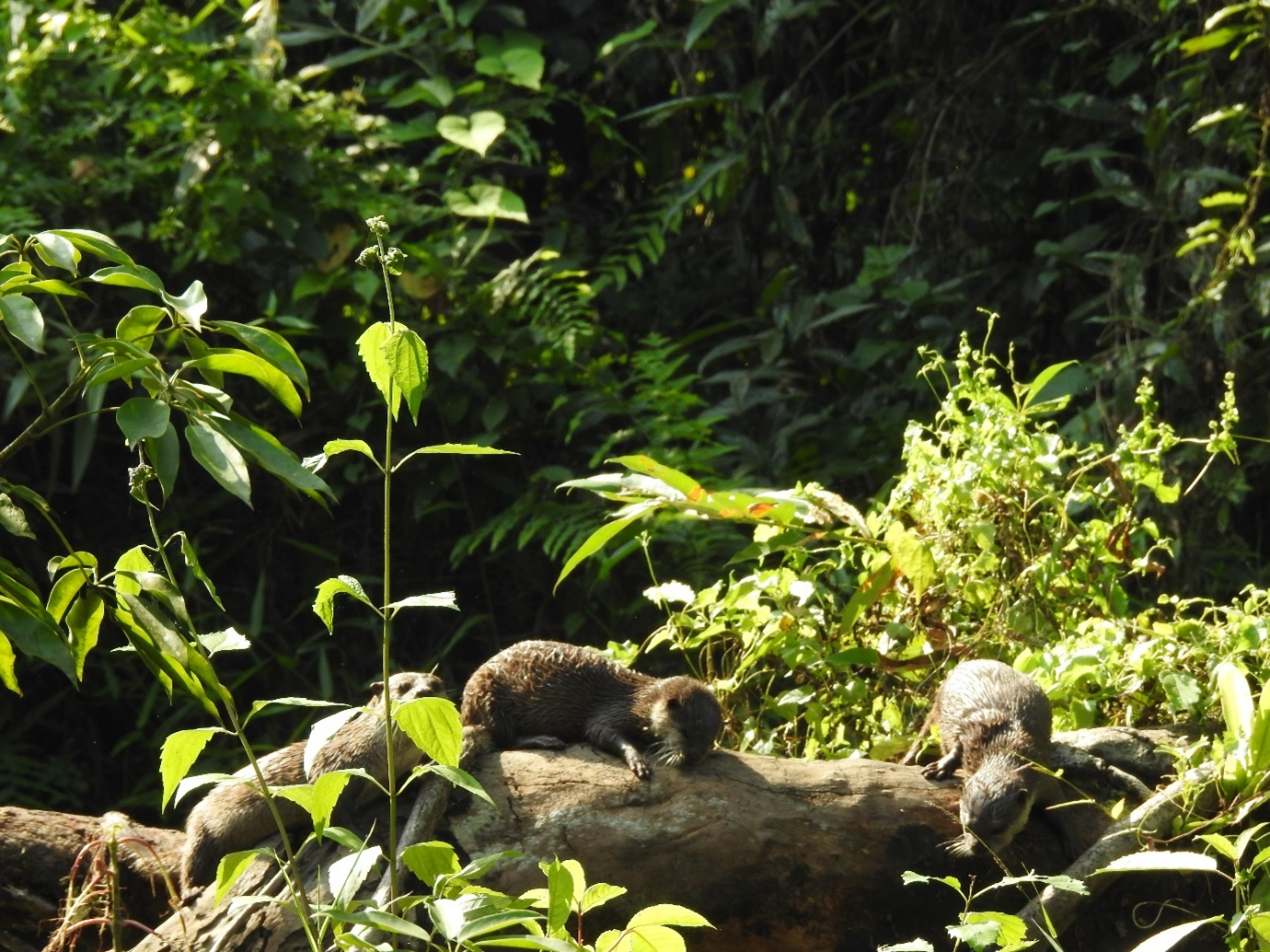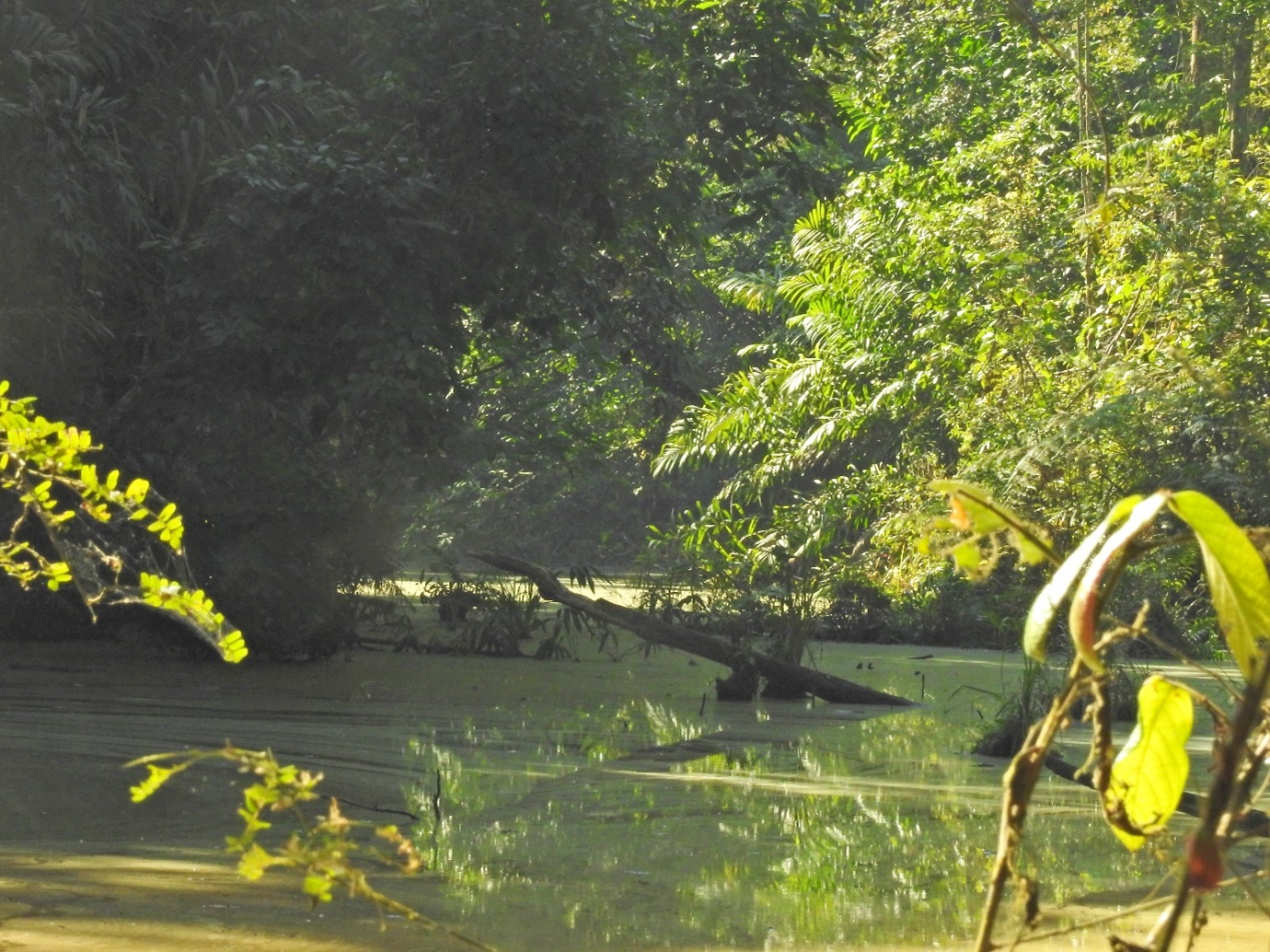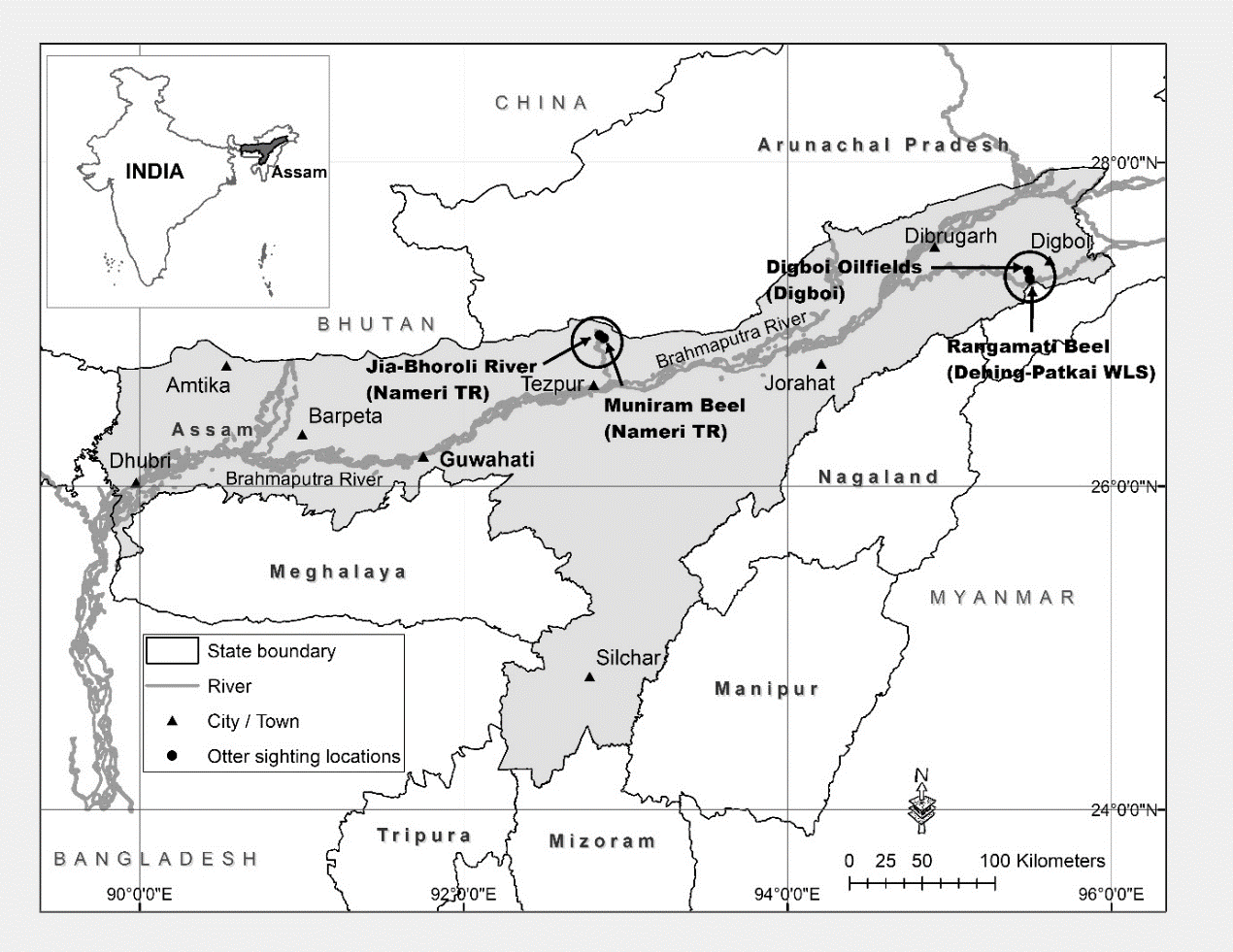IUCN/SSC Otter Specialist Group Bulletin

©IUCN/SCC Otter Specialist Group
Volume 38 Issue 1 (January 2021)
Citation: Menzies, R.K. and Rao, M. (2021). Incidental Sightings of the Vulnerable Asian Small-Clawed Otter (Aonyx cinereus) in Assam, India: Current and Future Threats. IUCN Otter Spec. Group Bull. 38 (1): 38 - 44
Incidental Sightings of the Vulnerable Asian Small-Clawed Otter (Aonyx cinereus) in Assam, India: Current and Future Threats
Rohan K. Menzies And Megha Rao
Nature Conservation Foundation, 1311, “Amritha”, 12th Main, Vijayanagar 1st Stage, Mysore 570 017, Karnataka, India. E-mail rohanmenzies@ncf-india.org
(Received 21st May 2020, accepted 10th August 2020)
Abstract: The Asian Small-clawed Otter (Aonyx cinereus) is the smallest otter species in the world and is listed as Vulnerable due to the large number of threats they face, ranging from habitat loss to hunting. This report highlights the importance of Asian Small-clawed Otter habitats in Assam, India, through four incidental sightings; two with photographic records.
Keywords: Aonyx cinereus, Asian Small-clawed Otter, Assam, India, Wildlife Management
INTRODUCTION
The Asian Small-clawed Otter (Aonyx cinereus) is listed as Vulnerable according to the IUCN Red List and India is the westernmost range for the species globally (Wright et al., 2015). The Asian Small-clawed Otter is one of three species of river otters found in India, the others being the Eurasian Otter (Lutra lutra) and the Smooth-coated Otter (Lutra perspicillata). In India, the Asian Small-clawed Otter’s range extends from north to northeast India, a separate range in south India which includes the Western Ghats (Hussain et al., 2011), and most recently the state of Odisha (Mohapatra et al., 2014). Asian Small-clawed Otters are given the highest level of protection under the Wildlife Protection Act (1972) in India; however, there are still threats which impact the populations in northeast India. Globally, this threatened species is impacted by a number of causes which contribute to their declining populations: hunting, logging, overfishing, dams, water pollution, and development of infrastructure in or near their habitat (Wright et al., 2015). Hunting of the species is prevalent in northeast India, where otters continue to be poached in Arunachal Pradesh and transported to Assam for sale at extremely high prices (Datta et al., 2008; Aiyadurai et al., 2010). Poaching potentially extends to the state of Assam as well. The Asian Small-clawed Otters are primarily hunted for their pelts, which has a high demand in the colder regions of northeast India, Tibet, and China. This report elucidates our sightings of Asian Small-clawed Otters from Assam, India, threats observed, and an insight into future threats we accrued by speaking to local community members.
STUDY AREA
Between November 2018 and March 2019, we surveyed the forested pools and streams for the Endangered White-winged Duck (Asarcornis scutulata) in Assam, India. All Asian Small-clawed Otter sightings mentioned here are incidental and were recorded during our surveys. The project focused on a state-wide survey for the White-winged Duck including repeated visits to sites over five months of fieldwork. The Asian Small-clawed Otter is a predominantly nocturnal and crepuscular species, observations from northeast India are limited to those captured on camera-traps with few real-time observations. Explicit sighting records of the species from particular locations in Assam are rare and could be important to depict accurate distribution ranges and numbers. From Nameri Tiger Reserve, for example, surveys from 1999-2010 only recorded the Eurasian Otter and Smooth-coated Otter (Saikia and Saikia, 2012). We hope that the sightings reported here from Assam (Fig. 1) add to the literature and conservation efforts of Asian Small-clawed Otters in India.
OBSERVATIONS
The first sighting was on 03 November 2018 at approximately 09h30 at Muniram Beel in Nameri Tiger Reserve, western Assam (26° 55’N, 92° 52’E). There were three individuals on the bank of the pond and they allowed us to observe them for over 20 minutes. From the shore, in what appeared to be a den, they got into the water and foraged for a while. The three otters were constantly swimming around but were always close to each other. They then climbed on top of a fallen tree trunk, perhaps to sun themselves, where we were able to photograph them (Fig. 2). These otters were fairly active that morning and according to the Forest Department staff and our field assistant, they are rarely seen by visitors and almost impossible to photograph. The forest pool site is one of two main waterbodies inside the protected area, and Muniram Beel is afforded higher protection as it is not accessible to tourists. The number of researchers working in the area are also low and hence these notes are important for the area. The water in the pond was clear and it appeared to have a healthy fish population. There was short, shrubby vegetation along the sides of the pond which likely provide security for otters to feed there. We also observed fallen logs in the water in around the beel which may be preferred by the otters. There is an anti-poaching camp close to the site and therefore experiences low levels of human disturbance at the pond. It is a relatively undisturbed location and if maintained, could be of regular, long-term importance to Asian Small-clawed Otters in the forest.

On 04 November 2018 at 07h20, also at Nameri Tiger Reserve, a pair of otters were seen in the main river, Jia-Bhoroli (26º 56’N, 92º 50’E), which forms the southern border of the Tiger Reserve, thus separating it from the reserve forest on the other bank. After crossing the river by boat to enter the park, we were walking towards the forest edge on a sandy stretch where we noticed two otters in the water. They were feeding in the middle of the river, in a stretch which did not have too many rapids. The otters then found a log in the river to climb (Fig. 3). Due to the boat rides, that section of the river is inundated by a number of visitors. Not all visitors enter the park but their impact can be seen near the water. The otters also had to tolerate garbage in the water and on the banks. This area is also fished by the locals, is prone to frequent boat traffic, tourists who river raft and fish, and has a significant level of human presence which could deter otters. We even encountered villagers who were fishing close to where the otters were first seen. Unlike Muniram Beel, the Jia-Bhoroli River seems a less likely place to observe otters regularly based on the human presence observed along the river.

The third sighting of Asian Small-clawed Otters took place at Rangamati Beel in Soraipung on 30 November 2018 at approximately 15h00. Rangamati Beel is part of the Dehing-Patkai Biosphere Reserve (27º 17’N, 95º 30’E) in Dibrugarh district, Assam. While conducting a habitat survey of the pond, we observed two otters swimming in the water. We did not notice them feeding and were more likely playing in the water. They were alerted to our presence because of the dry leaves underfoot and began swimming away from us and took shelter in a small island in the pond. The undergrowth at the point of sighting made it impossible to get a photograph; however, all four observers got a clear look at the two otters. Rangamati Beel is one of the largest, permanent waterbodies in the protected area (Fig. 4). It gets its name from the murky, muddy water and is relatively rich in terms of biodiversity. Several birds occupy this forested pool and a number of reptiles were seen on many occasions, including Common Indian Monitors (Varanus bengalensis) and Assam Roofed Turtle (Pangshura sylhetensis). During this same survey, we also saw the endangered White-winged Duck fly from one end of the pool to the other. Leopards are also known to regularly visit this pond. This beel is very important for these species; however, we did also observe signs of fishing around the water. There is road access until about a kilometre away from the pool and unfortunately, according to the locals, there are plans to construct another road which would run right beside Rangamati. This would be extremely damaging to the landscape and the rare species dependent on it, including the Asian Small-clawed Otters.

On the 09 December 2018 at approximately 08h00, we observed a lone Asian Small-clawed Otter in a small stream at the Digboi Oilfields in the district of Tinsukia, Assam (27º 20’N, 95º 29’E). The stream is located right opposite a boiler unit which consists of a large reservoir inside Digboi Oilfields. Excess water from the reservoir flows into this particular stream. The two are separated by a road and the water flows below the road through a canal and joins the stream. The otter was seen for a few seconds swimming near the roots of a tree growing at the edge of the stream. It could not be photographed but it sensed our presence before swimming away and hiding. This location was very close to the boiler unit and is one of the busier roads in the area. We later left the stream to continue our work and when we returned, we saw over ten fishermen at the stream, diverting the water by moving the rocks and catching fish with traps. Some fishermen were at the opening of the possible tree den and the part of the stream where the otter was seen was now turbid because of the water diversion and movement of fishermen. We later informed the Forest Department of these observations. There are several forested streams in the area and we requested more monitoring of this stream in particular since otter presence was confirmed. We also suggested some signage on the road to warn against illegal fishing.
DISCUSSION AND CONCLUSIONS
The incidental sightings of Asian Small-clawed Otters in Assam are positive for the species, not simply as an indication of their presence, but also to suggest how these areas can be maintained and improved. The current threats we observed include high levels of fishing in otter habitat (and the subsequent disturbance), garbage in the rivers, and uncontrolled human disturbances. It is also important to note that the high level of fishing does not only impact the food resources of the otters but also severely affects their habitat. In winters, it is common practice in several parts of Assam, including the Dehing-Patkai range which has other ongoing threats (https://www.hindustantimes.com/india-news/large-parts-of-assam-s-elephant-reserve-mined-without-wildlife-nod/story-NFh0yNncJ3PiUePrlUGJ7J.html), to empty small waterbodies such as forested pools in order to catch all the fish in a pond. This unsustainable method of fishing not only depletes fish populations but is also detrimental to the otter’s habitat. The main future threat observed was at Rangamati Beel where road construction could damage the entire landscape. Asian Small-clawed Otters are an important species for these forested pools and to the riverscapes of northeast India. It is crucial that more species-specific surveys are conducted in the region for otters. Conducting research on these ecosystems in the future should also address threats and how it can be mitigated. The requirements outlined in 0 also holds true for the otter populations in Assam since much of it is within human-modified landscapes or are on the verge of being modified. Hunting of otters will be difficult to tackle given the ever-increasing demand in Assam; however, awareness programmes on the importance of the species could slow down the negative impacts on otters. A rigorous plan which involves surveys, research, and developing a management plan could be highly beneficial for the species.
Acknowledgements: We are grateful to Rohit Naniwadekar for his support during our project. We thank Divya Mudappa and Nisarg Prakash for confirming the species from our photographs. We are grateful to Bhaskar Bora for logistical support at Dehing-Patkai and R Raghunath for the map. We thank the Assam Forest Department for granting us permission to work in the region (WL/FG.31/Pt/Technical Committee/2018) and for assisting with logistical support for fieldwork. We also thank all the field assistants in Assam who helped us carry out the fieldwork. Our project was funded by Wildlife Conservation Trust (India), Ravi Sankaran Foundation (India), and Rufford Small Grants for Nature Conservation (23932-1) without which these records on otters would not have been possible.
REFERENCES
Aiyadurai, A., Singh, N.J., Milner-Gulland, E.J. (2010). Wildlife hunting by indigenous tribes: a case study from Arunachal Pradesh, north-east India. Oryx, 44(4): 564-572.
Datta, A., Naniwadekar, R., Anand, M.O. (2008). Occurrence and conservation status of small carnivores in two protected areas in Arunachal Pradesh, north-east India. Small Carnivore Conservation, 39: 1-10.
Hussain, S.A., Gupta, S.K., de Silva, P.K. (2011). Biology and Ecology of Asian Small-Clawed Otter Aonyx cinereus (Illiger, 1815): A Rev Spec. Group Bull, 28(2): 63-75.
Mohapatra, P.P., Palei, H.S., Hussain, S.A. (2014). Occurrence of Asian small-clawed otter Aonyx cinereus (Illiger, 1815) in Eastern India. Current Science, 107(3): 367-370.
Prakash, N., Mudappa, D., Shankar Raman, R.T., Kumar, A. (2012). Conservation of the Asian small-clawed otter (Aonyx cinereus) in human-modified landscapes, Western Ghats, India. Tropical Conservation Science, 5(1): 67-78.
Saikia, M.K., Saikia, P.K. (2012). Wildlife habitat evaluation and mammalian checklist of Nameri National Park, Assam, India. Bioresearch Bulletin, 4: 185-199.
Wright, L., de Silva, P., Chan, B., Reza Lubis, I. (2015). Aonyx cinereus. The IUCN Red List of Threatened Species 2015: e.T44166A21939068. http://dx.doi.org/10.2305/IUCN.UK.2015-2.RLTS.T44166A21939068.en. Downloaded on 19 May 2020.
Observations Accidentelles de la Loutre Cendrée d’Asie (Aonyx cinereus), Vulnérable, dans l’Assam, en Inde: Menaces Actuelles et Futures
La loutre cendrée d’Asie (Aonyx cinereus) est la plus petite espèce de loutre au monde et est classée vulnérable en raison du grand nombre de menaces qui pèsent sur elle, allant de la perte d’habitat à la chasse. Ce rapport souligne l’importance des habitats de la loutre cendrée d’Asie dans l’Assam, en Inde, à travers quatre observations accidentelles dont deux avec des archives photographiques.
Revenez au dessus
Resumen: Avistajes Incidentales de la Vulnerable Nutria de Uñas Pequeñas Asiática (Aonyx cinereus) en Assam, India: Amenazas Actuales y Futuras
La Nutria de Uñas Pequeñas Asiática (Aonyx ciniereus) es la especie de nutria más pequeña del mundo, y está listada como Vulnerable, debido al gran número de amenazas que enfrenta, desde pérdida de hábitats hasta cacería. Este informe destaca la importancia de los hábitats de Nutria de Uñas Pequeñas Asiática en Assam, India, a través de cuatro avistajes incidentales; dos de ellos con registros fotográficos.
Vuelva a la tapa
